This year, we were fortunate enough not to miss having some fresh matsutake 松茸 offered by Oregon mushrooms to celebrate the start of the fall season. In the past we have tried several other sources but the #1 grade matsutake from the Oregon mushrooms is our favorite choice. In any case we received 1lb. I have tried many matsutake dishes but I think the simpler the better. Three dishes I make are Toubanyaki 陶版焼き, chawan-mushi 茶碗蒸し and matsutake rice. 松茸ご飯. Another dish I usually make is clear soup with matustake; either matsutake “osuimono” 松茸のお吸い物 clear soup or dobin-mushi 土瓶蒸し. This time, I made Touban-yaki for the evening we received Matsutake. The next evening I made another touban-yaki, chawan-mushi and Matsutake-rice. The day following that I made Matsutake clear soup and served it with left-over matsutake rice.
Classically, the soup contains a small filet of conger eel or “hamo” 鱧 or other white fish filet but, since we did not have any, I used “Hanpen“ ハンペン fish cake. Other items included tofu, carrot, “Hana-fu” 花麩 gluten cake shaped like a flower. Since I wanted a bit of green, I added small florets of blanched broccoli. I also topped this with frozen “yuzu” 柚子 Japanese citrus rind. I only cooked the soup a few minutes after I added the matsutake. The broth was made from my usual dashi packets, seasoned with mirin, salt and soy sauce.
Since I had old asazuke 浅漬け (3-4 week old) and one I just made the previous day, I served both side-by-side for comparison (the one on the left is 1 day old the one on the right is 1 month old). The old asazuke developed slightly sour but more complex flavors and the young asazuke is fresh tasting but a bit simpler taste. I adjusted the original recipe by adding a bit more salt (instead of standard 3% I add 5% salt) as well as a small amount of Vodka. This makes the asazuke last much longer so 1 month old asazuke is even possible.
We are glad we had matsutake to commemorate the start of the fall.
Showing posts with label Matsutake. Show all posts
Showing posts with label Matsutake. Show all posts
Tuesday, September 26, 2023
Saturday, October 29, 2022
Tako rice and Matsutake soup for lunch タコ飯と松茸のお吸い物昼食
This was a lunch we had one day. We had leftover frozen octopus rice or “Tako meshi” たこめし made from a kit we got from the Rice factory. Although the original was not bad, the amount of octopus was rather small. Since I made tender simmered octopus タコの柔らか煮 a few days ago, I added slices of octopus legs to the previously made rice. Also we had matsutake mushroom 松茸 from Maine and made clear matsutake soup 松茸のお吸い物. I added a dish of salted vegetable or “asazule” 浅漬け and simmered root vegetables and chicken similar to “Chikuzen-ni” 筑前煮.
Tuesday, October 19, 2021
Matsutake from Maine メイン州からの松茸
We have been getting fresh Matsutake from the Oregon mushroom for many years and I have made all the dishes I can think of. This year when I looked on their web site matsutake was listed “out of stock”. So I decided to look into alternatives sources. I found fresh matsutake available from Maine at a site called “Foraged”. It appears this is the web hub for individual foragers. I ordered some matsutake from the site and ours came from a forager in Bangor, ME. One of the forager’s ad even states “Picked to order”. I did not know Maine has matsutake (I know Oregon and Colorado produced North American Matsutake). Oregon mushroom has different grades for matustake and I have been getting “grade #1” which has unopened caps. “The Foraged” did not have different grades. As shown in the picture below what arrived were large with opened caps (These are after I cleaned).
Because of the open caps and gills, it is a bit more difficult to clean and also had more “worm holes” than the ones from the Oregon mushroom.
I had posted all matsutake dishes I can think of as I mentioned earlier. I prepared the classic dishes from the Maine matsutake such as “Matsutake rice” and “Grilled matustake on a toban yaki grill”.This Maine matutake had good flavor and we had a "Matsutake feast" one evening which included "Matsutake toban-grill” 松茸の陶板焼き, "chawan-mushi" 松茸の茶碗蒸し, "Dobinmushi-like soup" 松茸の土瓶蒸しもどき and ended with "Matsutake rice" 松茸ご飯 .
Then, I served the matsutake soup somewhat like a traditional “dobin-mishi” but since I do not have proper "dobin" 土瓶 I made dobin-mushi -like soup in a mini-donabe.
For the broth, I made #1 broth or "ichiban dashi" using kelp and bonito flakes. I also added steamed renkon ball, shrimp, daikon, carrot, shelled edamame and ginko nuts.
Because of the open caps and gills, it is a bit more difficult to clean and also had more “worm holes” than the ones from the Oregon mushroom.
I had posted all matsutake dishes I can think of as I mentioned earlier. I prepared the classic dishes from the Maine matsutake such as “Matsutake rice” and “Grilled matustake on a toban yaki grill”.
The below are the first group of matsutake dishes. Since I could not get a Japanese citrus called “Sudachi” スダチ, which is typically used with matsutake dishes, I used wedges of lime which is closest among the readily available citrus.
I cooked touban-yaki on the stove with the lid on so the matsutake grilled and steamed at the same time keeping the aroma in. I happended to get shell-on ginko nuts or “ginnan” 銀杏 from Tako Grill, which I prepared a few days before, I coated the nuts with salt and grilled them with the matsutake.
This chawan-mushi is mostly matsutake and a few ginko nuts and shelled edamame, and small chunks of shrimp. I also added chopped chives since I had it.
I cooked touban-yaki on the stove with the lid on so the matsutake grilled and steamed at the same time keeping the aroma in. I happended to get shell-on ginko nuts or “ginnan” 銀杏 from Tako Grill, which I prepared a few days before, I coated the nuts with salt and grilled them with the matsutake.
The matsutake-rice was prepared the night before. So I just microwave but it came back really nicely. So we think this feast did justice to the celebration of autumnal dishes ushering in the new season.
Monday, September 9, 2019
Matsutake feast 2019 松茸尽くし 2019
Oregon mushrooms just started shipping North American fresh matsutake. Although North American matsutake is no comparison to the Japanese or even Mexican variety, we usually get them just to commemorate the season. As I posted before, this matsutake requires more aggressive cleaning since the dirt is embedded into the skin of the mushroom and just rubbing with a moist towel does not do the job. I have posted everything posted here and some more. But this is a once a year matsutake feast.
Since I do not have an appropriate set of "dobin-mushi" 土瓶蒸し vessels, I used mini-donabes to serve Matsutake soup 松茸のお吸い物.
For color, I added blanched broccolini, thinly shaved carrot and chives. I also added cubes of cod and shrimp.
The soup base is bonito-kelp broth (using a dashi pack) and seasoned with mirin and light colored "usukuchi" soy sauce 薄口醤油. The cod and shrimp (Venezuelan red shrimp), both were previously frozen, stored in our freezer and thawed the morning I made the dish. I salted and marinated them in sake before adding to the soup. Upon opening the lids of the soup containers, the lovely matsutake aroma wafted up. (This initial whiff of matsutake fragrance is one of the traditional "enjoyments" of this dish.) This is the first time I used cod for this type of soup (any gentle tasting white meat fish will do). The cod was thick fleshed and tender and really good. The shrimp was sweet and excellent as well.
I was planning to have a chawanmushi 松茸の茶碗蒸し next but it took longer than I planned for it to finish cooking so I served matustake touban yaki 松茸の陶板焼き next. We enjoyed it simply with salt and lemon.
Finally, the chawanmush was done. For this batch, I added the cod, shrimp, kyo-bu 京麩 (dried gluten cake, rehydrated), a cube of dashimaki だし巻き Japanese omelet (egg-in-egg idea). As usual, I made six so that we could enjoy the "leftovers" later.
I garnished it with finely chopped fresh chives. The soft egg custard was infused with matsutake aroma/flavor.
#1. This is the amount of matsutake I used for 6 small chawanmushi (about three matsutake).
#2. The first layer of the chawanmush is, of course, the matsutake.
#3. Kyo-bu is a small decorative gluten cake from Kyoto. It does not have any taste by itself. Just texture and whatever it absorbed.
#4. Shrimp.
#5. Cod.
#6. Cube of dashimaki.
This was a sort-of treasure hunt. We love chawanmushi of any kind but this was a bit special. I used to add ginko nuts which, in the past, were readily available in a can (boiled) but not anymore for some reason. They just disappeared and we have not seen them anywhere. Finally we finished our feast with matsutake-gohan 松茸ご飯. This time I think I made it perfectly. The rice was slightly firm but well cooked.
For this occasion, I wheeled out my special "Kamado-san" earthenware rice cooking pot (#1). As per the instructions, I set the inner lid with its steam holes arranged perpendicular to the outer lid steam hole; necessary for the rice to cook properly(#2). As usual, I used bonito-kelp broth seasoned with mirin and light colored soy sauce which I enhanced by adding rehydrated strips of kelp and soaking liquid. When the lid was lifted, the smell the matsutake and freshly cooked rice (good combination) wafted up (#3). I mixed the rice and the matsutake before serving (#4).
Besides, the matsutake dishes, we had a few more of our usual appetizers and cold sake. Once a year, this is worth doing.
Since I do not have an appropriate set of "dobin-mushi" 土瓶蒸し vessels, I used mini-donabes to serve Matsutake soup 松茸のお吸い物.
For color, I added blanched broccolini, thinly shaved carrot and chives. I also added cubes of cod and shrimp.
The soup base is bonito-kelp broth (using a dashi pack) and seasoned with mirin and light colored "usukuchi" soy sauce 薄口醤油. The cod and shrimp (Venezuelan red shrimp), both were previously frozen, stored in our freezer and thawed the morning I made the dish. I salted and marinated them in sake before adding to the soup. Upon opening the lids of the soup containers, the lovely matsutake aroma wafted up. (This initial whiff of matsutake fragrance is one of the traditional "enjoyments" of this dish.) This is the first time I used cod for this type of soup (any gentle tasting white meat fish will do). The cod was thick fleshed and tender and really good. The shrimp was sweet and excellent as well.
I was planning to have a chawanmushi 松茸の茶碗蒸し next but it took longer than I planned for it to finish cooking so I served matustake touban yaki 松茸の陶板焼き next. We enjoyed it simply with salt and lemon.
Finally, the chawanmush was done. For this batch, I added the cod, shrimp, kyo-bu 京麩 (dried gluten cake, rehydrated), a cube of dashimaki だし巻き Japanese omelet (egg-in-egg idea). As usual, I made six so that we could enjoy the "leftovers" later.
I garnished it with finely chopped fresh chives. The soft egg custard was infused with matsutake aroma/flavor.
#1. This is the amount of matsutake I used for 6 small chawanmushi (about three matsutake).
#2. The first layer of the chawanmush is, of course, the matsutake.
#3. Kyo-bu is a small decorative gluten cake from Kyoto. It does not have any taste by itself. Just texture and whatever it absorbed.
#4. Shrimp.
#5. Cod.
#6. Cube of dashimaki.
This was a sort-of treasure hunt. We love chawanmushi of any kind but this was a bit special. I used to add ginko nuts which, in the past, were readily available in a can (boiled) but not anymore for some reason. They just disappeared and we have not seen them anywhere. Finally we finished our feast with matsutake-gohan 松茸ご飯. This time I think I made it perfectly. The rice was slightly firm but well cooked.
For this occasion, I wheeled out my special "Kamado-san" earthenware rice cooking pot (#1). As per the instructions, I set the inner lid with its steam holes arranged perpendicular to the outer lid steam hole; necessary for the rice to cook properly(#2). As usual, I used bonito-kelp broth seasoned with mirin and light colored soy sauce which I enhanced by adding rehydrated strips of kelp and soaking liquid. When the lid was lifted, the smell the matsutake and freshly cooked rice (good combination) wafted up (#3). I mixed the rice and the matsutake before serving (#4).
Besides, the matsutake dishes, we had a few more of our usual appetizers and cold sake. Once a year, this is worth doing.
Friday, December 2, 2016
Matsutake 松茸
We got a shipment of North American Matsutake from Oregon mushrooms the last week of September. Among the North American matsutake, the ones from Mexico are the most similar to the ones in Japan but, for us, the ones from Oregon are a good balance between flavor and price. I have posted many matsutake dishes previous so this time I just made one composite post to signify the fall season.
Unlike Japanese matsutake, these Oregon matsutake are covered with dirt which is difficult to remove using just wet paper towels. So, I usually end up scraping the surface of the mushroom with a sharp paring knife. It is the pretty unpleasant to bite into grit either sand or dirt while eating matsutake.
We started with a few small dishes before we delved into feasting on the matsutake this evening. As shown below we had stir fried cabbage with abura-age similar to stir fried beef and cabbage I post before. I served this with spicy marinated tofu but instead of baking the tofu as I did previously, I cooked it in a frying pan. I first browned the pieces without sauce and then poured in the sauce and cook until the sauce was reduced. We found this is much better preparation than when they are baked. The tofu maintains its moisture with nice "piri-kara" spicy hot and salty flavor. I served this after a brief microwaving.
The cabbage dish is classic Japanese home cooking. Instead of meat, deep dried tofu pouch or abura-age is used cut into small strips and sauteed with vegetable oil and a splash of dark sesame oil and red pepper flakes. I then braised it in mirin and soy sauce. I garnished it with blanched broccoli.
The second small dish was made from something I usually discard. In preparation for making the matsutake dishes, I made a broth from kelp and dried bonito flakes (katsuo-bushi). I made two kinds of broths; Ichi-ban (#1) dashi and ni-ban (#2) dashi (一番だし、2番だし)*. I decided to make the leftover spent kelp and bonito flakes to a dish by braising them in mirin and soy sauce until the moisture was almost all gone. This is a type of "Tsukudani" 佃煮. Although these items were "spent" by making broth, they are still full of "umami". My wife was pleasantly surprised this dish went well with the Napa Cab we were drinking.
* #1 broth: After simmering the kelp for 10 minutes in water, I added dried bonito flakes and let it simmer for 30 seconds then cut the flame. I let it steep for another 5 minutes and then strained it without pressing. #2 broth: I put the kelp and the bonito used to make #1 broth back into the pan and added water. I let this mixture simmer for 30 minutes and then strained it. #1 dashi is the premier extraction of dashi flavors. The best analogy would be to say it is like cold pressed extra virgin olive oil while #2 dashi is like second press with heat light olive oil. #1 dashi is best used in clear soups or chawan-mushi and #2 broth is good for simmered dishes.
This is the first matsutake dish of the evening. I made matsutake touban-yaki. This time I did not add sake to steam it.
Even off the flame, the touban or ceramic disc retained heat. Upon opening the dome, the subtle but rather distinct aroma of matsutake wafted up. The steam rising from it is just visible in the picture below. We simply enjoyed this with lime (in leu of "kabosu" カボス) and Kosher salt. Of course we switched to cold sake at this point. Since we were drinking sake from Yamagata, we used "Tsugaru-nuri" sake cups we got from the Aomori prefecture (both are northern prefectures in the mainland).
The second matsutake dish I made was chawanmushi. Since I did not have any special ingredients, I made this with what I had on hand. I put in some shrimp (thawed, shelled, deveined, and cut into small chunks), ginko nuts (from a can), and boiled North American chestnuts I had prepared previously. On the top were slices of matsutake, hana-fu 花麩 (decorative gluten cake, hydrated), the green part of scallion and yuzu skin (frozen).
Although there is a good amount of matsutake is in this dish, it is difficult to see in the picture. This is another of our favorite ways of enjoying matsutake. The egg custard was silky smooth. (I used #1 dashi broth for this dish seasoned with mirin, light colored soy sauce and salt).
At this point, we were getting filled up, so I skipped the matsutake clear soup 松茸のも吸い物 I had planned and went to the last dish of matsutake rice 松茸御飯. As usual, I used the "Kamado-san" かまどさん donabe 土鍋 rice cooker. I used a mixture of #1 and #2 broth, lightly seasoned with sake and light colored soy sauce. I also added small pieces of kelp.
This time I did not intentionally make browned crust or "okoge" おこげ to maintain the delicate flavor of the matustake. The rice developed a very nice sheen.
I ate my serving as is; enjoying the subtle flavor and aroma of the matsutake and rice. But when I wasn't looking my wife added pats of butter to hers. (She confessed it was sublime)
The sake we had was called "kudoki jouzu" or pick-up artist, Junmai Ginjou くどき上手 純米吟醸 from Kamenoi shuzou 亀の井酒造 in Yamagata prefecture 山形県. Yamagata has many good sake breweries including "Juyondai sake" 十四代 of Takagi shuzou 高木酒造. This is made from 美山錦 miyama-nishiki which is the sake rice adapted to colder climate as I understand it. This is a nice clean sake with crisp acidity and the floral quality of Daiginjou. Ture sake website describes this sake as follows; "Great name and a great nose on this sake with hints of pear, apple, and purple plum aromas. Ahhhhh! A brew that gets it. A terrific feeling sake that fills the mouth with fat and gooey flavors but stays super smooth. The brilliant acidity-balancing act takes the sweetness out of the gambit of fruit flavors including pineapple and mango. Plump and complex this "sexy beast" is layered and luxurious with attitude and swagger. Drink closer to room temp if you want even more fruit tones, but chilled is happening." which we agree for the most part. We enjoyed matsutake this evening. Only regret I have is that I could not arrange to have some nice sashimi with this.
Friday, October 16, 2015
All Matsutake lunch 松茸尽くしの昼食
Since it was Matsutake 松茸 season, we ordered fresh matsutake from Oregon Mushroom as usual. They offer grade #1 and grade#2/#3 with grade#1 being the better matsutake with unopened caps. This year, they had some problem harvesting grade#1 matsutake and there was some delay before we received it. Around the same time, we received Northern American chestnuts from Gilolami farms. So, we have two major ingredients for our annual autumnal feast. I have posted all the chestnut and matsutake recipes I can think of previously. In any case, on one weekend, we had this all matsutake lunch consisting of matsutake rice 松茸ご飯, chawanmushi 松茸茶碗蒸しand clear soup 松茸のお吸物.
I made the Matsutake rice the night before using the Kamado-san donabe rice cooker.

I heated the rice for lunch just microwaving it and topping it with thin slices of fresh matsutake. I garnished with green part of scallion. The fresh matsutake slices added a wonderful subtle aroma to this dish.

I also made matsutake chawanmushi and clear soup for this lunch. For both, I used a filet of sole which was first salted and sprinkled with sake, cut into bite sized pieces and gently poached (I turned off the heat after I added the sole) in dashi broth for few minutes (as usual, I made it with a dashi pack containing dried bonito flakes and kelp).
In the chawanmush, I only included thinly sliced matsutake and small pieces of poached dover sole filet. I garnished with snow peas (added to the chawanmush at the last 5 minutes of steaming) and garnished with yuzu skin (from frozen packed) and scallion.

I made clear soup from the same prepared broth seasoned with light colored soys sauce or usukuchi shouyu 薄口醤油, a splash of mirin and salt. I added silken tofu from Japan, matsutake slices. I also added yuzu skin and snow pea.

This was a rather luxurious lunch. The sole filet was very mild in flavor and had a melt-in-your-mouth consistency which was very nice. The chawamushi was lava hot initially but the silky consistency and subtle matsutake aroma were sublime. We succumbed to having our house sake daiginjou "MU" 大吟醸 無--but just one glass.
I made the Matsutake rice the night before using the Kamado-san donabe rice cooker.

I heated the rice for lunch just microwaving it and topping it with thin slices of fresh matsutake. I garnished with green part of scallion. The fresh matsutake slices added a wonderful subtle aroma to this dish.

I also made matsutake chawanmushi and clear soup for this lunch. For both, I used a filet of sole which was first salted and sprinkled with sake, cut into bite sized pieces and gently poached (I turned off the heat after I added the sole) in dashi broth for few minutes (as usual, I made it with a dashi pack containing dried bonito flakes and kelp).
In the chawanmush, I only included thinly sliced matsutake and small pieces of poached dover sole filet. I garnished with snow peas (added to the chawanmush at the last 5 minutes of steaming) and garnished with yuzu skin (from frozen packed) and scallion.

I made clear soup from the same prepared broth seasoned with light colored soys sauce or usukuchi shouyu 薄口醤油, a splash of mirin and salt. I added silken tofu from Japan, matsutake slices. I also added yuzu skin and snow pea.

This was a rather luxurious lunch. The sole filet was very mild in flavor and had a melt-in-your-mouth consistency which was very nice. The chawamushi was lava hot initially but the silky consistency and subtle matsutake aroma were sublime. We succumbed to having our house sake daiginjou "MU" 大吟醸 無--but just one glass.
Friday, October 3, 2014
Matsutake, chestnuts and tuna sashimi 秋の味覚とマグロの刺身
This time, all the goodies I ordered came at the same time which included matsutake 松茸, Northern American Chestnuts 北米産栗 and tuna 本マグロ, amaebi 甘エビ and uni うに. from Catalina. I have posted matsutake and chestnut dishes many times before but we can only have these items once a year so I still take delight in their arrival. In addition, on the same day, we received sashimi items from Catalina (the sashimi was scheduled to arrive that day but it just so happened that the other items while not scheduled for delivery arrived the same day). This fortuitous coincidence called for an "akino mikaku" 秋の味覚 or tastes of autumn feast.
I used the fresh matustake from Oregon, by cooking them steamed with sake in a touban grill . We like this way of cooking matustake best (after trying many other dishes). The wafting smell of the matsutake when I remove the dome-shaped lid is the best and one of the pure enjoyments of the experience. I simply served with kosher salt and a wedge of lemon.

I also served a small sashimi of amaebi and uni. The amaebi was very fresh and sweet (some were still alive when they arrived). The uni was "premium uni" and, to be truthful, not that great. Since I had boiled chestnuts, I also served one.
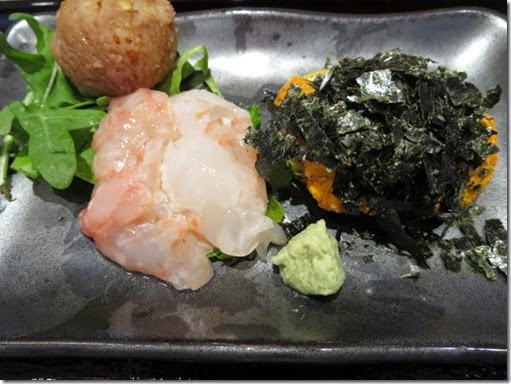
We also had chestnut rice as shime dish with a miso soup with heads of anaebi.
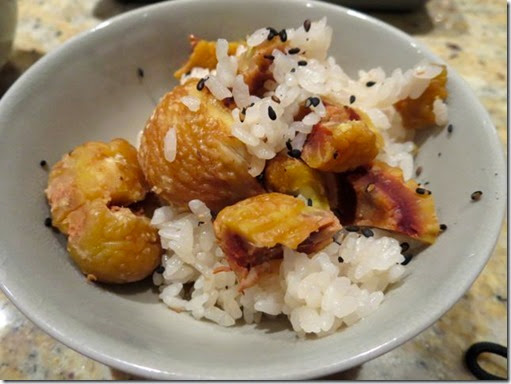
Here are the matsutake from Oregon mushroom. As you can see they were quite dirty. This time many stalks were left with knife gashes indicating they were not carefully harvested.
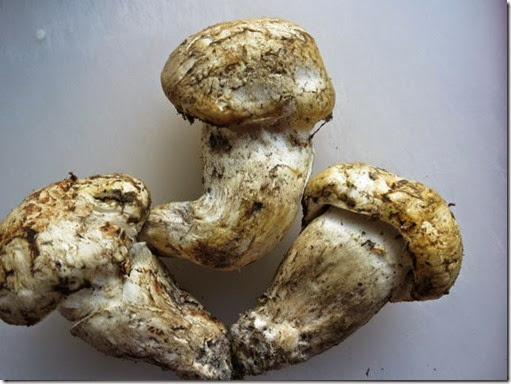
Most of instructions for cleaning matsutake indicate that after shaving off the stem ends with embedded dirt as you would if sharpening a pencil, gently rub off the dirt using a wet dish towel. I didn’t think this would work well. Nothing is worse than biting into sand and dirt when eating matsutake. So after cleaning as above, I use a sharp paring knife and cut off or scraped off the thin surface layers to make sure no sand or dirt remained (see below).
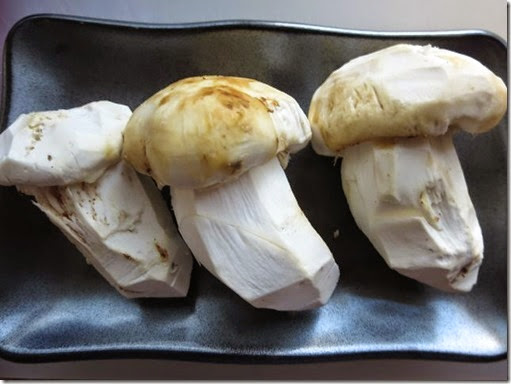
These are the “colossal” chestnuts we received.
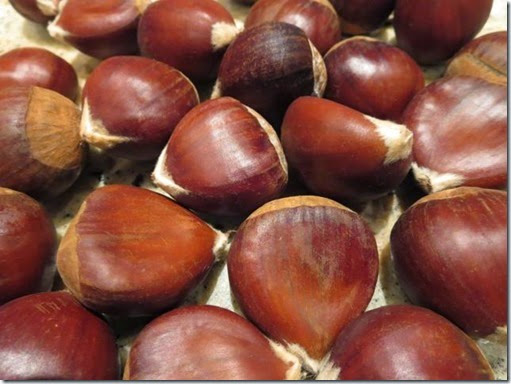
I used the chestnuts to make chestnut rice. In previous years I used a mixture of “glutenous” “mochi gome” rice 餅米 and regular short grain rice, this year, I used all imported Koshihikari コシヒカリ rice from Niigata. I cooked it using “Kamadosan” earthenかまどさん pot rice cooker (see below).
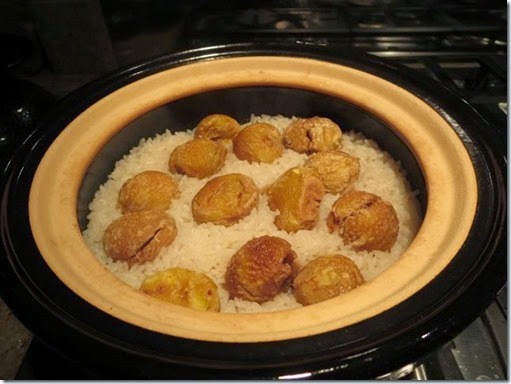
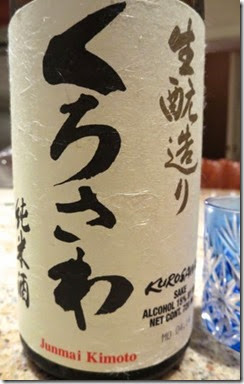 For libation, we had junmaishu 純米酒 called “Kurosawa” くろさわ from Kurosawas shuzou 黒澤酒造 in Nagano 長野. This was made by an old process called “Kimoto” 生酛 in which naturally occurring lactic fermentation is used instead of inoculation with lactobacillus. Although, Ginjou and Daiginjou sake are elegant and clean and crisp, sometimes we like to taste a more down-to-earth sake flavor and “Junmai” class is the best bet for this. This one is not overly yeasty (which often happens in this class of sake) and had a slight sweet note with distinctive honey suckle after taste. We really liked it although a bit more acidity may have been better. In any case, sipping Kurosawa with all these autumn tastes, we feel we did justice to the celebration of the arrival of autumn.
For libation, we had junmaishu 純米酒 called “Kurosawa” くろさわ from Kurosawas shuzou 黒澤酒造 in Nagano 長野. This was made by an old process called “Kimoto” 生酛 in which naturally occurring lactic fermentation is used instead of inoculation with lactobacillus. Although, Ginjou and Daiginjou sake are elegant and clean and crisp, sometimes we like to taste a more down-to-earth sake flavor and “Junmai” class is the best bet for this. This one is not overly yeasty (which often happens in this class of sake) and had a slight sweet note with distinctive honey suckle after taste. We really liked it although a bit more acidity may have been better. In any case, sipping Kurosawa with all these autumn tastes, we feel we did justice to the celebration of the arrival of autumn.
I used the fresh matustake from Oregon, by cooking them steamed with sake in a touban grill . We like this way of cooking matustake best (after trying many other dishes). The wafting smell of the matsutake when I remove the dome-shaped lid is the best and one of the pure enjoyments of the experience. I simply served with kosher salt and a wedge of lemon.

I also served a small sashimi of amaebi and uni. The amaebi was very fresh and sweet (some were still alive when they arrived). The uni was "premium uni" and, to be truthful, not that great. Since I had boiled chestnuts, I also served one.

We also had chestnut rice as shime dish with a miso soup with heads of anaebi.

Here are the matsutake from Oregon mushroom. As you can see they were quite dirty. This time many stalks were left with knife gashes indicating they were not carefully harvested.

Most of instructions for cleaning matsutake indicate that after shaving off the stem ends with embedded dirt as you would if sharpening a pencil, gently rub off the dirt using a wet dish towel. I didn’t think this would work well. Nothing is worse than biting into sand and dirt when eating matsutake. So after cleaning as above, I use a sharp paring knife and cut off or scraped off the thin surface layers to make sure no sand or dirt remained (see below).

These are the “colossal” chestnuts we received.

I used the chestnuts to make chestnut rice. In previous years I used a mixture of “glutenous” “mochi gome” rice 餅米 and regular short grain rice, this year, I used all imported Koshihikari コシヒカリ rice from Niigata. I cooked it using “Kamadosan” earthenかまどさん pot rice cooker (see below).

 For libation, we had junmaishu 純米酒 called “Kurosawa” くろさわ from Kurosawas shuzou 黒澤酒造 in Nagano 長野. This was made by an old process called “Kimoto” 生酛 in which naturally occurring lactic fermentation is used instead of inoculation with lactobacillus. Although, Ginjou and Daiginjou sake are elegant and clean and crisp, sometimes we like to taste a more down-to-earth sake flavor and “Junmai” class is the best bet for this. This one is not overly yeasty (which often happens in this class of sake) and had a slight sweet note with distinctive honey suckle after taste. We really liked it although a bit more acidity may have been better. In any case, sipping Kurosawa with all these autumn tastes, we feel we did justice to the celebration of the arrival of autumn.
For libation, we had junmaishu 純米酒 called “Kurosawa” くろさわ from Kurosawas shuzou 黒澤酒造 in Nagano 長野. This was made by an old process called “Kimoto” 生酛 in which naturally occurring lactic fermentation is used instead of inoculation with lactobacillus. Although, Ginjou and Daiginjou sake are elegant and clean and crisp, sometimes we like to taste a more down-to-earth sake flavor and “Junmai” class is the best bet for this. This one is not overly yeasty (which often happens in this class of sake) and had a slight sweet note with distinctive honey suckle after taste. We really liked it although a bit more acidity may have been better. In any case, sipping Kurosawa with all these autumn tastes, we feel we did justice to the celebration of the arrival of autumn.
Subscribe to:
Posts (Atom)






































